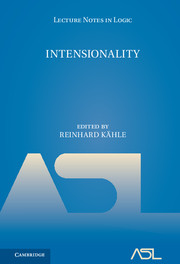Book contents
- Frontmatter
- Preface
- Contents
- The modal aether
- Possible worlds semantics for predicates
- A context principle
- The semantics of modal predicate logic II. Modal individuals revisited
- Intensionality and coercion
- Intensionality in philosophy andmetamathematics
- Representation theorem for models of dynamic intensional logic
- Intension, intention
- Modality, mood, and descriptions
- Coercion vs. indeterminacy in opaque verbs
- References
Coercion vs. indeterminacy in opaque verbs
Published online by Cambridge University Press: 30 March 2017
- Frontmatter
- Preface
- Contents
- The modal aether
- Possible worlds semantics for predicates
- A context principle
- The semantics of modal predicate logic II. Modal individuals revisited
- Intensionality and coercion
- Intensionality in philosophy andmetamathematics
- Representation theorem for models of dynamic intensional logic
- Intension, intention
- Modality, mood, and descriptions
- Coercion vs. indeterminacy in opaque verbs
- References
Summary
Introduction. This paper is about the semantic analysis of opaque verbs such as seek and owe, which allow for unspecific readings of their indefinite objects. One may be looking for a good car without there being any car that one is looking for; or, one may be looking for a good car in that a specific car exists that one is looking for. It thus appears that there are two interpretations of these verbs—a specific and an unspecific one—and one may wonder how they are related. The present paper is a contribution to this question.
History
Paris. The time of the holy inquisition. Opaque verbs differ in their semantic behaviour from ordinary verbs. This phenomenon was already known to the medieval logician Buridanus:
I posit the case that for a good service you performed forme, I promised you a good horse. […] And since I owe you this, until I have paid that concerning the payment of which I have obligated myself […], you could rightly take action against me to bring about payment to you of a horse, which you could not do if I did not owe you. […] But the opposite is argued in a difficult way.
[Buridanus (1966 [1350]: 137)]The followingmodern version of the opposite argument is less verbose than the original:
Let us then have our horse-coper arguing again. “If I owe you a horse, then I owe you something. And if I owe you something, then there is something I owe you. And this can only be a thoroughbred of mine: you aren't going to say that in virtue of what I said there's something else I owe you. Very well, then: by your claim, there's one of my thoroughbreds I owe you. Please tell me which one it is.”
[Geach (1965: 430)]The two arguments are based on two different ways of reading the sentence under debate (1) — an obvious, unspecific interpretation and a somewhat remote, specific one.
Information
- Type
- Chapter
- Information
- Intensionality , pp. 217 - 265Publisher: Cambridge University PressPrint publication year: 2005
References
Accessibility standard: Unknown
Why this information is here
This section outlines the accessibility features of this content - including support for screen readers, full keyboard navigation and high-contrast display options. This may not be relevant for you.Accessibility Information
- 2
- Cited by
